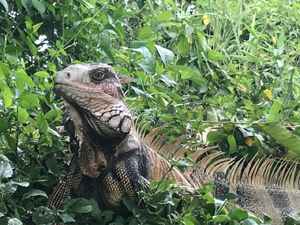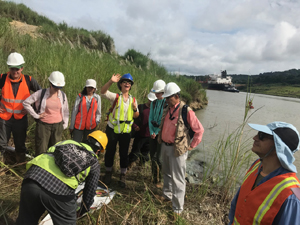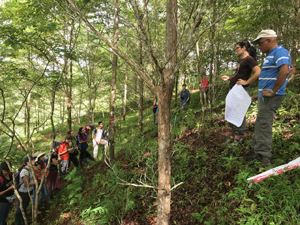Submitted by Administrator on Wed, 19/09/2018 - 09:13
Part II Zoology student and field course participant, Libby Daley (Pembroke), writes...
 This year, the Zoology department launched its first long-awaited tropical field course to the sleepy, canalside town of Gamboa, Panama. Set against a backdrop of passing cargo ships and lush tropical forest, the Smithsonian Institute’s schoolhouse provided comfortable accommodation to three lecturers, two supervising PhD students and twenty lucky Cambridge students for two memorable weeks. We were additionally joined by five students from Panama and Colombia whose expertise, ranging widely from botany to insect physiology, were rapidly recognised and became huge assets to the team.
This year, the Zoology department launched its first long-awaited tropical field course to the sleepy, canalside town of Gamboa, Panama. Set against a backdrop of passing cargo ships and lush tropical forest, the Smithsonian Institute’s schoolhouse provided comfortable accommodation to three lecturers, two supervising PhD students and twenty lucky Cambridge students for two memorable weeks. We were additionally joined by five students from Panama and Colombia whose expertise, ranging widely from botany to insect physiology, were rapidly recognised and became huge assets to the team.
The first week of the course was a whirlwind tour of the sights of the canal region of the country with the purpose of impressing upon us the supreme diversity and natural beauty of the region. The jam-packed schedule prepared for us had several notable highlights. We were treated to awe-inspiring views of the rainforest canopy from the Sherman canopy crane, and explored Pipeline road, a site globally renowned for the abundance and diversity of avian fauna found there. Day trips to Las Cascadas fossil site and the Agua Salud Project further provided a fascinating insight into the ongoing paleobiological research in the region and the scientific investigation of reforestation methods aiming to preserve water supply to the canal. A water taxi took us to the isolated nature reserve of Barro Colorado Island, formed when damming of the Chagres river created Gatun Lake, and we stayed overnight at the field station which hosts numerous scientific researchers every year. Throughout the course, we were delighted by sightings of sloths, howler and spider monkeys, iguanas, agoutis, capybara, armadillos, snakes, caiman, tree frogs, toads and a truly extraordinary diversity of both birds and insects. On our final night a group, working with camera traps, even recorded an unconfirmed sighting of an ocelot.

In the second week, we were given free reign of Gamboa and the surrounding rainforest region to conduct research projects of our choosing. As the data collected will be analysed and written up, under supervision, as part II projects during term time, these projects will allow us to conduct and follow the full process of scientific research, from conception to “publishing” the finished paper. Reflecting the diversity of interests in our group, project subjects varied from leafcutter ant traffic to mammal diversity, and the trip culminated in a mini-symposium of project presentations.
In the evenings, alongside relaxation, a series of pertinent and interesting talks were given by our lecturers, PhD’s and guest academics working in the area on a variety of subjects, including Anolis lizard evolution, the origin of the Panama Isthmus and invasive species in the Panama Canal. We are very grateful to Dr Allen Herre who generously hosted a final night party; a fun end to a wonderful trip.
Overall, the Panama trip was an unmitigated success, enjoyed hugely by all that went. The beauty and diversity of the tropical rainforest, experienced in a new and different way, was inspirational and the fieldwork skills developed will surely prove invaluable to further study in the coming years.
 In the interest of sustainability, carbon offsetting was purchased to cover the emissions associated with our plane tickets. The Stand for Trees website was used to support the Gola Forest project, Sierra Leone, which is a partnership between the Conservation Society of Sierra Leone, the national government and RSPB and is accredited by both the Verified Carbon Standard and the Climate, Community and Biodiversity Alliance.
In the interest of sustainability, carbon offsetting was purchased to cover the emissions associated with our plane tickets. The Stand for Trees website was used to support the Gola Forest project, Sierra Leone, which is a partnership between the Conservation Society of Sierra Leone, the national government and RSPB and is accredited by both the Verified Carbon Standard and the Climate, Community and Biodiversity Alliance.
Photos by Chris Jiggins, one of the course leaders.
Also see @CamZoologyField on Instagram
